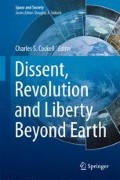Abstract
It’s something of a truism in physics that closed systems tend to entropy. If we contain a process—if we close it in, in some way—it will degrade faster than it normally would. And this principle clearly applies beyond physics. John B. Calhoun, for example, famously documented the elevated entropy of closed systems with rat populations Calhoun (Proc. Roy. Soc. Med. 66: 80–88, 1973). He gave his animals everything they could possibly need, but enclosed them in a limited space. Inside of their closed system, some males became aggressive, others withdrew psychologically, females stopped caring for their young, and eventually their population plummeted, even though they had plenty of food. Humans are not rats, of course: we are self-referential, thinking beings. Subjected to fully closed systems, we break down mentally. And it is precisely the entropy of closed human systems that underlies this chapter. I will be examining dissent: Cases of dissent where flight was an option, and cases of dissent where flight was not an option. The great difference in space, of course—once we have sufficient technology—is that flight is nearly always an option; on Earth, unfortunately, it is often not a realistic option.
Access this chapter
Tax calculation will be finalised at checkout
Purchases are for personal use only
Notes
- 1.
Manuelian (1998).
- 2.
- 3.
Foster (1988).
- 4.
Fitzpatrick (1994).
- 5.
Snyder (2010).
- 6.
Marples (2007).
- 7.
Friedländer (1997).
- 8.
Among other sources, I have verified these facts with several survivors of this holocaust in personal discussions.
- 9.
Morgan-Witts and Gordon (1994).
- 10.
Koenigsberger et al. (1999).
- 11.
Durant (1953).
- 12.
Cockell et al. (2015).
- 13.
Marrus (1985).
- 14.
See the Wikipedia page on “Expatriation tax”.
- 15.
Rummel (1977).
References
Calhoun, J. B. (1973). Death squared: The explosive growth and demise of a mouse population. Proceedings of Royal Society Medicine, 66, 80–88.
Cockell, et al. (2015). The meaning of liberty beyond earth. Berlin: Springer.
Der Manuelian, P. (1998). Egypt: The world of the pharaohs. Bonner Straße, Cologne Germany: Könemann Verlagsgesellschaft mbH.
Durant, W. (1953). The renaissance. New York: Simon & Schuster.
Fitzpatrick, S. (1994). Stalin’s peasants: Resistance and survival in the Russian village after collectivization (pp. 3–18). Oxford: Oxford University Press.
Foster, R. F. (1988). Modern Ireland 1600–1972. London: Penguin Group.
Friedländer, S. (1997). The years of persecution: Nazi Germany and the Jews 1933–1939. London: Weidenfeld & Nicolson.
Kennedy, L., Ell, P. S., Crawford, E. M., Clarkson, L. A. (1999). Mapping the great Irish Famine. Ireland: Four Courts Press.
Koenigsberger, H. G., Mosse, G. L., Bowler, G. Q. (1999). Europe in the sixteenth century (2nd Edn). Longman: Routledge.
Marples, D. R. (2007). Heroes and villains: Creating national history in contemporary Ukraine (p. 50). Hungary: Central European University Press.
Marrus, M. (1985). The unwanted: European refugees in the twentieth century. New York: Oxford University Press.
Morgan-Witts, M., Gordon, T. (1994). Voyage of the damned (2nd, revised (first in 1974) ed.). Stillwater, Minnesota: Motorbooks International.
Gráda, C. Ó., Mokyr, J., (1984) New developments in Irish population history 1700–1850. Economic History Review, xxxvii(4), 473–488.
Rummel, R. J. (1977). Power kills: Democracy as a method of nonviolence. New Brunswick: Transaction Books.
Snyder, T. (2010). Bloodlands: Europe between Hitler and Stalin. London: The Bodley Head.
Author information
Authors and Affiliations
Corresponding author
Editor information
Editors and Affiliations
Rights and permissions
Copyright information
© 2016 Springer International Publishing Switzerland
About this chapter
Cite this chapter
Rosenberg, P. (2016). What Happens to Dissent When Flight Is a Present Option?. In: Cockell, C. (eds) Dissent, Revolution and Liberty Beyond Earth. Space and Society. Springer, Cham. https://doi.org/10.1007/978-3-319-29349-3_12
Download citation
DOI: https://doi.org/10.1007/978-3-319-29349-3_12
Published:
Publisher Name: Springer, Cham
Print ISBN: 978-3-319-29347-9
Online ISBN: 978-3-319-29349-3
eBook Packages: Physics and AstronomyPhysics and Astronomy (R0)

